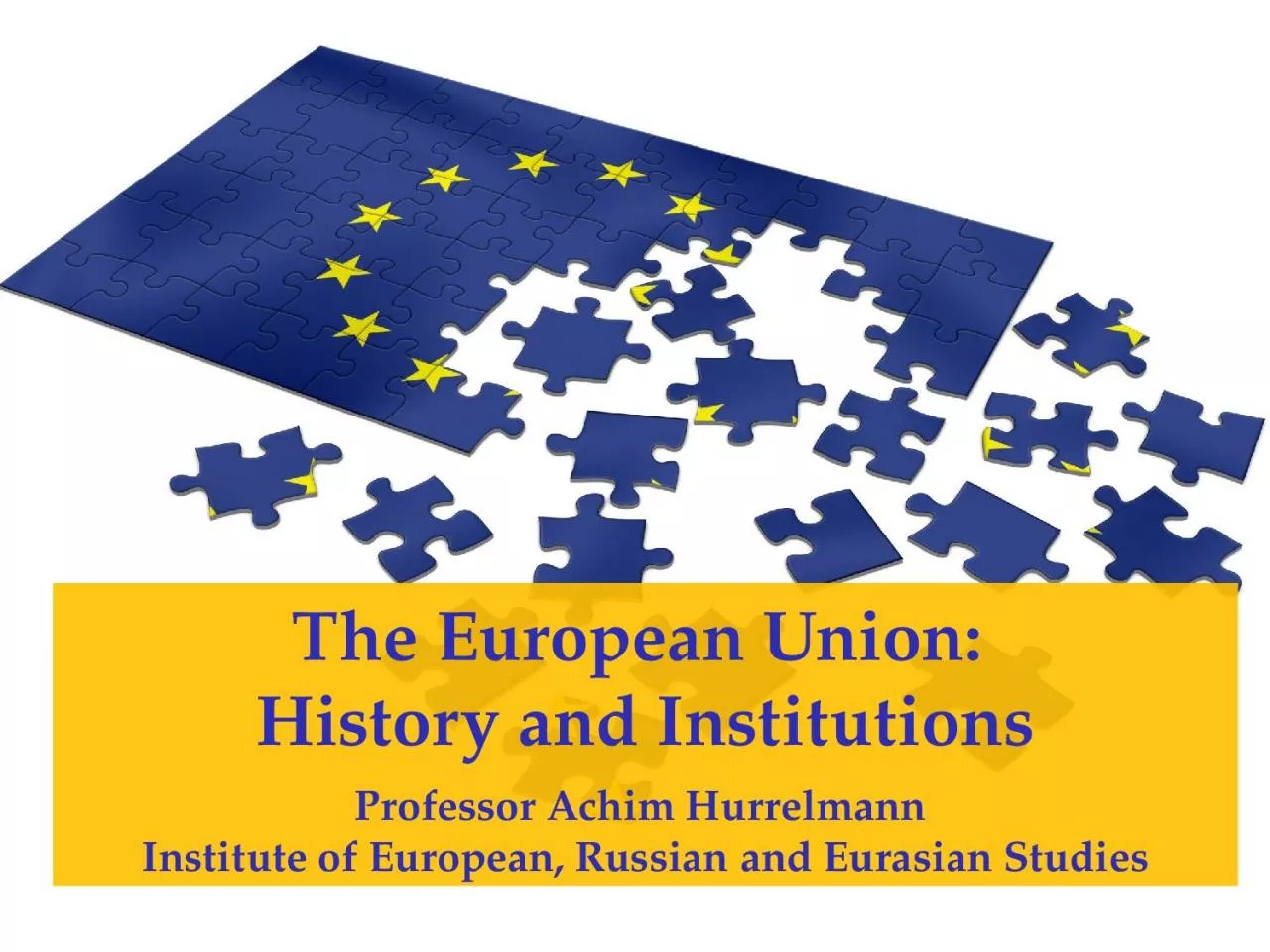

Professor Achim Hurrelmann Institute of European Russian and Eurasian Studies European Union EU Member states and candidates for accession Member States Potential Candidate States ID: 1029128
Download Presentation The PPT/PDF document "The European Union: History and Institu..." is the property of its rightful owner. Permission is granted to download and print the materials on this web site for personal, non-commercial use only, and to display it on your personal computer provided you do not modify the materials and that you retain all copyright notices contained in the materials. By downloading content from our website, you accept the terms of this agreement.
1. The European Union: History and InstitutionsProfessor Achim Hurrelmann Institute of European, Russian and Eurasian Studies
2. European Union (EU) -- Member states and candidates for accession Member States (Potential) Candidate StatesCroatia became an EU member state on July 1, 2013
3. European integration: Initiated in Western Europe in aftermath of World War II; context marked by political and economic reconstruction, beginning of Cold WarThree Communities created in 1950s: European Coal and Steel Community (ECSC), European Atomic Energy Community (Euratom) and European Economic Community (EEC), with six member statesTwo trajectories of development: (1) Accession of more member states (“widening”), and (2) transfer of further powers to European institutions, coupled with shift to supranational decision making (“deepening”)History of the EU
4. “Widening” integrationOriginal members: Germany, France, Italy, Benelux1973: UK, Ireland, Denmark1981: Greece1986: Portugal, Spain1990: East Germany1995: Austria, Sweden, Finland2004: CEE countries, Cyprus, Malta2007: Bulgaria, Romania2013: Croatia
5. 1963/64: Court of Justice strengthens Community law against member states1985: Single European Act abolishes member-state veto in many policy areas, strengthens European Parliament1991: Maastricht Treaty lays groundwork for the Euro; European Union established in addition to Communities1997/2000: Amsterdam and Nice Treaties reform EU institutions prior to enlargement2007: Lisbon Treaty simplifies institutional structure, gives EU unified legal personality in force since 2009Since 2010: Euro crisis leads to greater coordination of member state fiscal policies“Deepening” integration
6. EU institutionsInstitutionGovernance roleCompositionEuropean Council (Brussels)Defines legislative, executive objectivesMember state leaders(intergovernmental)European Commission (Brussels)Executive, some legislative functions EU bureaucrats (supranational)Council of Ministers (Brussels)Legislative, some executive functionsMember state ministers (intergovernmental)European Parliament(Strasbourg, Brussels)LegislativeElected MEPs (supranational)Court of Justice(Luxembourg)JudiciaryEU judges (supranational)European Central Bank(Frankfurt)Regulatory (monetary policy)Central bankers (supranational)
7. Summits of heads of state or government from all member states, permanent president (Herman Van Rompuy)Discusses pressing issues; defines policy objectives; decides on institutional reform and key personnelDecisions usually consensualEuropean CouncilInstitutionGovernance roleCharacterEuropean Council (Brussels)Defines legislative and executive objectivesIntergovernmentalEuropean Commission (Brussels)Executive, legislative, regulatory SupranationalCouncil of Ministers (Brussels)Legislative, some executive functionsIntergovernmentalEuropean Parliament(Strasbourg, Brussels)LegislativeSupranationalCourt of Justice (Luxembourg)Judiciary SupranationalEuropean Central Bank(Frankfurt)RegulatorySupranational
8. One Commissioner per member state, responsible for specific portfolio, headed by president (Jean Claude Juncker)Initiates EU legislation; manages EU programs and finances; monitors implementation of EU law; some regulatory functonsMost decisions consensualEuropean CommissionInstitutionGovernance roleCharacterEuropean Council (Brussels)Defines legislative and executive objectivesIntergovernmentalEuropean Commission (Brussels)Executive, legislative, regulatory SupranationalCouncil of Ministers (Brussels)Legislative, some executive functionsIntergovernmentalEuropean Parliament(Strasbourg, Brussels)LegislativeSupranationalCourt of Justice (Luxembourg)Judiciary SupranationalEuropean Central Bank(Frankfurt)RegulatorySupranational
9. One minister per member state; composition varies by policy field; presidency rotates between member states every six monthsMust pass all binding EU laws; monitors Commission; some executive powersDecides unanimously or per qualified majority (QMV)Council of MinistersInstitutionGovernance roleCharacterEuropean Council (Brussels)Defines legislative and executive objectivesIntergovernmentalEuropean Commission (Brussels)Executive, legislative, regulatory SupranationalCouncil of Ministers (Brussels)Legislative, some executive functionsIntergovernmentalEuropean Parliament(Strasbourg, Brussels)LegislativeSupranationalCourt of Justice (Luxembourg)Judiciary SupranationalEuropean Central Bank(Frankfurt)RegulatorySupranational
10. European Parliament751 elected members, organized in trans-national party groups, chaired by president (Martin Schulz)Must pass EU laws in most policy areas (together with Council); scrutiny of CommissionUsually decides by simple majorityInstitutionGovernance roleCharacterEuropean Council (Brussels)Defines legislative and executive objectivesIntergovernmentalEuropean Commission (Brussels)Executive, legislative, regulatory SupranationalCouncil of Ministers (Brussels)Legislative, some executive functionsIntergovernmentalEuropean Parliament(Strasbourg, Brussels)LegislativeSupranationalCourt of Justice (Luxembourg)Judiciary SupranationalEuropean Central Bank(Frankfurt)RegulatorySupranational
11. Court of Justice28 judges, appointed by member states, chaired by president (Vassilios Skouris)Makes decisions on interpretation of EU law; cases often brought by national courtsMost decisions made in chambers of 3 or 5 judgesInstitutionGovernance roleCharacterEuropean Council (Brussels)Defines legislative and executive objectivesIntergovernmentalEuropean Commission (Brussels)Executive, legislative, regulatory SupranationalCouncil of Ministers (Brussels)Legislative, some executive functionsIntergovernmentalEuropean Parliament(Strasbourg, Brussels)LegislativeSupranationalCourt of Justice (Luxembourg)Judiciary SupranationalEuropean Central Bank(Frankfurt)RegulatorySupranational
12. European Central BankExecutive Board composed of President (Mario Draghi) and five other members; Governing Council composed of central bank governors of Euro statesGoverning Council makes decisions on monetary policy for all Euro statesECB took on responsibility for bank supervision in 2014Most decisions consensualInstitutionGovernance roleCharacterEuropean Council (Brussels)Defines legislative and executive objectivesIntergovernmentalEuropean Commission (Brussels)Executive, legislative, regulatory SupranationalCouncil of Ministers (Brussels)Legislative, some executive functionsIntergovernmentalEuropean Parliament(Strasbourg, Brussels)LegislativeSupranationalCourt of Justice (Luxembourg)Judiciary SupranationalEuropean Central Bank(Frankfurt)Regulatory (monetary policy)Supranational
13. EU governance -- Key characteristicsLegislation: EU is an active producer of legislation, which is binding on the member states and trumps national lawImplementation: EU laws are generally implemented by the member states, under the supervision of CommissionAdjudication: Court of Justice is an activist court, often pushing integration furtherDemocracy: European Parliament is directly elected, but most citizens have little knowledge of – or interest in – EU politics